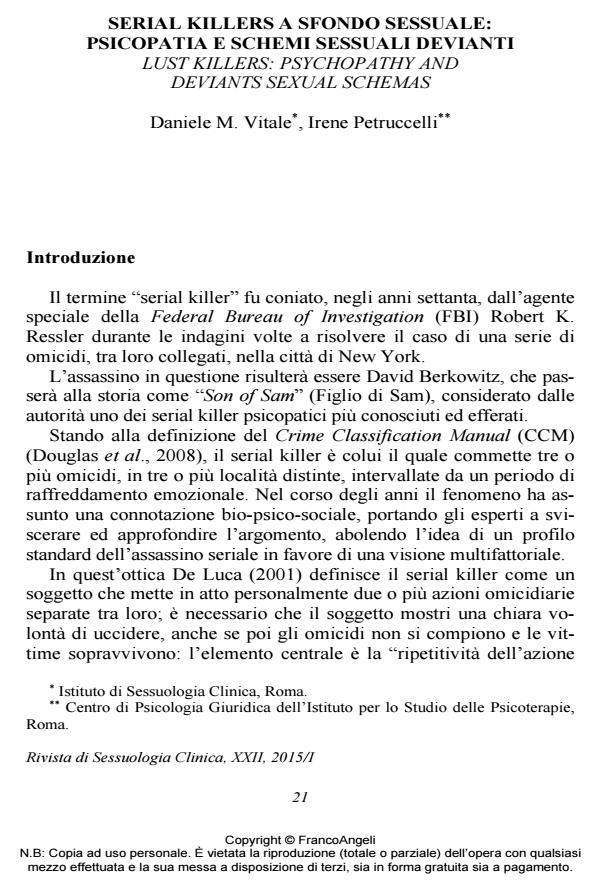Serial killers a sfondo sessuale: psicopatia e schemi sessuali devianti
Titolo Rivista RIVISTA DI SESSUOLOGIA CLINICA
Autori/Curatori Daniele M. Vitale, Irene Petruccelli
Anno di pubblicazione 2015 Fascicolo 2015/1
Lingua Italiano Numero pagine 26 P. 21-46 Dimensione file 108 KB
DOI 10.3280/RSC2015-001002
Il DOI è il codice a barre della proprietà intellettuale: per saperne di più
clicca qui
Qui sotto puoi vedere in anteprima la prima pagina di questo articolo.
Se questo articolo ti interessa, lo puoi acquistare (e scaricare in formato pdf) seguendo le facili indicazioni per acquistare il download credit. Acquista Download Credits per scaricare questo Articolo in formato PDF

FrancoAngeli è membro della Publishers International Linking Association, Inc (PILA)associazione indipendente e non profit per facilitare (attraverso i servizi tecnologici implementati da CrossRef.org) l’accesso degli studiosi ai contenuti digitali nelle pubblicazioni professionali e scientifiche
Il fenomeno dei serial killers a sfondo sessuale ha da sempre suscitato un forte interesse da parte della comunità scientifica nonostante non esista una copiosa letteratura sull’argomento. Nel corso degli anni l’attenzione a riguardo ha trovato terreno fertile tra gli esperti, che hanno presentato, così, il fenomeno come bio-psico-sociale, poiché, quella del serial killer, non è una personalità tracciabile in un unico profilo standard. Si è giunti, così, a parlare di multifattorialità: vengono considerati non solo gli aspetti psichiatrici, ma anche quelli psicosessuali e di sviluppo legati all’arco di vita dell’assassino seriale. Ciò che è stato universalmente riconosciuto in questi individui è un notevole deficit di empatia che li porterebbe ad agire in maniera efferata proprio perché incapaci di percepire il dolore della vittima. Questo articolo si pone come obiettivo quello di illustrare nel profondo la vera natura di soggetti che si macchiano di crimini sessuali, natura che è il frutto di concause non solo psicologiche, ma anche di sviluppo ed ambientali che trovano nelle teorie kleiniane un interessante spunto di riflessione su quelli che sono gli schemi sessuali maturati durante la fase di sviluppo del bambino. L’incapacità del serial killer sessuale di provare empatia verso la vittima sarebbe, in qualche modo, legato al mancato step di sviluppo che porta il bambino a passare dall’oggetto parziale all’oggetto totale.
Parole chiave:Serial killer, schemi sessuali devianti, narcisismo maligno, Gianfranco Stevanin, deficit di empatia, oggetto parziale
Daniele M. Vitale, Irene Petruccelli, Serial killers a sfondo sessuale: psicopatia e schemi sessuali devianti in "RIVISTA DI SESSUOLOGIA CLINICA" 1/2015, pp 21-46, DOI: 10.3280/RSC2015-001002